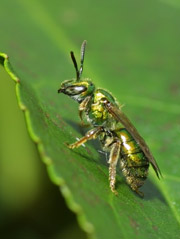The dating game: Social behavior of sweat bees evolved with Earth's warming a mere 20 million years ago, Cornell study finds
By Susan S. Lang

In the first study to link social evolution to climate change, Cornell University entomologists show that the social behavior of many species of sweat bees evolved simultaneously during a period of global warming.
This social evolution occurred much more recently than scientists ever thought -- only 20 million to 22 million years ago, compared with the social evolution of other insects, which evolved more than 65 million years ago.
"We believe that climatic change was a critical factor in the evolution of social behavior in these bees," said Bryan Danforth, associate professor of entomology at Cornell. Sweat bees are eusocial, he explained, which is a type of social behavior in which the animals have permanently sterile worker castes (among other traits). Eusocial animals include honey, bumble, carpenter and sweat (halictid) bees, ants, termites, many wasps as well as certain kinds of shrimp and the naked mole rat.
Danforth's study, to be published in a forthcoming issue of the Proceedings of the Royal Society of London, Series B, Biological Sciences, used both fossils as well as more than 2,300 base pairs of DNA sequences from three genes to infer the evolutionary history, or phylogeny, of the family's eusocial lineages and their relatives. The DNA sequencing sheds light on how divergent the various species are from each other, and the fossils allow the researchers to represent the phylogeny in terms of a timeline in millions of years.
In 2002 and 2004, Danforth showed that the social evolution of the various species of halictid bees arose multiple times independently. The study on the timing of that social evolution, however, began as an honors thesis for former Cornell undergraduate Adam Pearson '03, now a graduate student at the University of Connecticut, in collaboration with Danforth and two former Cornell postdoctoral researchers, Sean Brady and Sedonia Sipes.

"What's so interesting is that the social behavior that's characteristic of these insects arose 'simultaneously,' that is, within 2 million years, which is a very narrow window in evolutionary terms," said Danforth. "It's also news to us that the origin of sociality in halictid bees was so recent."
Once the team dated the evolution of the social behaviors to just 20 million to 22 million years ago, they researched what might have been going on in this time frame that would trigger the development of social behavior in so many species at the same time.
"We discovered that the Earth underwent a warming trend from 15 to 26 million years ago," Danforth said. "In modern halictid bees, social behavior varies among species and even within species as a function of latitude and altitude such that species and populations at low latitudes and in warmer regions are often fully social, whereas they are solitary at higher latitudes and altitudes, which are colder."
Warmer regions have longer growing seasons, he explained, which allows two broods to emerge instead of one. The first brood (workers) helps raise the second brood (reproductives).
Danforth, who teaches Alien Empire: Bizarre Biology of Bugs (Entomology 201), a two-credit course in insect biology, and maintains a Web site on bee phylogeny, http://www.entomology.cornell.edu/BeePhylogeny/, is also struck by the social flexibility of sweat bees.
"Other social insects (such as ants, termites, paper wasps and honey bees) have reached 'a point of no return' in social evolution in which members of the lineage are now unable to revert back to a solitary condition. These insects, however, seem to be able to revert fairly easily," he concluded.
Halictid bees, which are important native pollinators in the Northern Hemisphere, where there are about 1,000 species, are nicknamed sweat bees because they are attracted to the salts in human perspiration.
Media Contact
Get Cornell news delivered right to your inbox.
Subscribe